 zachary harden
zachary harden
Keywords: ufe | unidentified flags | 2018 |
Links: FOTW homepage | search | disclaimer and copyright | write us | mirrors

Last modified: 2025-02-07 by  zachary harden
zachary harden
Keywords: ufe | unidentified flags | 2018 |
Links: FOTW homepage |
search |
disclaimer and copyright |
write us |
mirrors
Please note our Policy for Submissions and Enquiries.
Below is a series of images of flags that have been provided to FOTW; some we have recognized, and some we have been unable to recognize. If you can help us identify any of these flags, please let us know! Contact the: UFE Editor.
Identification Key:
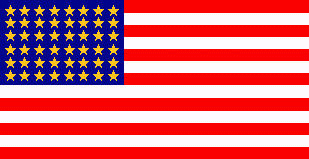 Speculative image by Pete Loeser, 12 March 2018
Speculative image by Pete Loeser, 12 March 2018
Recently I was just shown an American Flag with 48 gold stars and 48 white stars on the other side. It has the customary red and white stripes. There are no marking anywhere on the flag. The flag hooks are riveted into the inside white stripe with the hooks to fly the flag. This flag was given to a fallen soldier who died on the beaches of Normandy, on June 15, 1944. I have read some of your material [and pages connected] and based on that information, is it possible that only one other flag with all 48 gold stars on one side has been seen?
David L. Mahan, 12 March 2018
Did it look something like this speculative image? There was actually a 50-star version suggested by vexillologist Ed Mooney to celebrate the 50th Birthday of the 50-Star Flag in 2010, but no 48-star versions ever officially recognized. I don't know if anybody has actually drawn a 48-Star version, so here it is.
Pete Loeser, 12 March 2018
This flag old. All the stars are embroiled, 48 white stars on one side and 48 gold stars on the other. It was given to the family of a fallen soldier who was killed in action on the beach of Normandy. The material is cotton and has the hooks riveted on the white edge!
David L. Mahan, 13 March 2018
When an American serviceman is buried in a formal military funeral, at the end of the service an American flag is folded in a particular way. The result is a triangular "packet" that only shows on the outside the blue canton covered with stars (i.e. none of the red and white stripes can be seen because of how the flag is folded). After the folding is done, the flag is awarded to the family of the fallen serviceman. So here is my theory.
If the family gets awarded a flag like this, and then, say, puts it in an attic or something without unfolding it - what might happen is that the stars on the outside of the folded flag might be more exposed to the elements, and might yellow with age. While the stars on the inside of the folded flag might be more protected from the elements, and so would remain more like new. Then when the flag is finally unfolded the result would be a flag where the stars on one side are "gold", and the stars on the other side are still white.
Pure speculation on my part, but perhaps possible.
Karl Paananen, 7 April 2018
For this to happen, the flag would have had to been folded with the union on one side folded to the outside, the same outside. Wouldn't it seem more likely that the flag had hung against a wall somewhere, and the side catching the light recolouring?
Peter Hans van den Muijzenberg, 15 April 2018
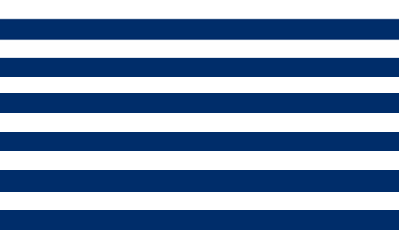 Speculative image from Pete Loeser, 12 March 2018
Speculative image from Pete Loeser, 12 March 2018
I trying to find the identity of a flag that was shown in a video shown at the Trenton New Jersey Visitor's Center, celebrating the "Ten Crucial Days" during the battles of Trenton and Princeton. When asked the people at the visitor's center did not know the identify of the flag shown in the video, which was generated by the New Jersey Network (similar to Public Broadcasting Station (PBS). The video is actually well done and does not contain any of the typical historical inaccuracies one sees in poorly edited videos.
The flag has basically about 6 horizontal white stripes alternating with about 6 horizontal blue stirpes; there is no canton. It looks like the Fort Mercer flag but lacks a canton- it has nothing but stripes.
It was being carried by a re-enactor across the screen and is clearly seen during the encampment around the Delaware River. The flag might be the flag of a local regiment, but I do not know. Can you help me?
Bob Wong, 12 March 2018
I'm trying to get a visual of the flag you describe. Was the top a white stripe or a blue stripe? With 12 stripes it would have a different color stripe at top or bottom. Dark blue or light blue? See attached speculative image.
Pete Loeser, 12 March 2018
Your picture is very much like what I saw. I cannot say for certain if there were 6 or 7 white or blue strips each, nor if the top one was white or blue. The re-enactor carrying the flag marched across the video screen for about 5 seconds, and I don't want to mislead you.
The video was reviewed by consultants at Washington's Crossing for historical accuracy, and the reenactors at Washington's Crossing are very serious about what they do, since they re-enact the Delaware River Crossing each year. So I am confident that it is a real flag at the time.
Bob Wong, 12 March 2018
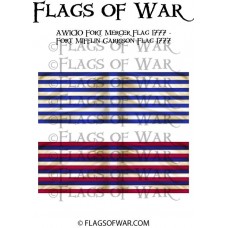 Image from Esteban Rivera, 12 March 2018
Image from Esteban Rivera, 12 March 2018
Here is graphical evidence (first flag from top to bottom) (source) that would lead to think that there was a variant flag for Ft. Mercer. Now, I do not know exactly if it is indeed a verified source. Still, I counted 13 stripes (seven blue, six white) though.
Esteban Rivera, 12 March 2018
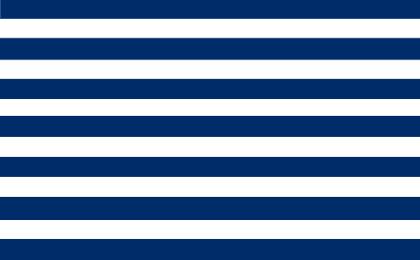 Speculative image by Pete Loeser, 12 March 2018
Speculative image by Pete Loeser, 12 March 2018
So perhaps a variant of the Ft. Mercer flag looking something like this? Interesting enough, the Fort Mifflin Garrison Flag, a fort which was located just across the river from Ft. Mercer, had a design with only stripes, but red, blue and white.
Pete Loeser, 24 March 2018
Please note the source given for this design is a War Games supplier in the UK. They offer a lot of flag images with no primary source.
Here's why: There were dozens of Continental Regiments 1775-1781; likewise British and "Hessian" regiments as well. If you are going to play a game with different units or fortifications involved, then each needs its own flag. We know of only a few real American flags from that era. Hence the need for a War Games supplier to make up flags.
Now, as far as the reenactors are concerned, take it from me as one who has partaken big time of this hobby (though now pretty much retired from it), you can find all kinds of Farby stuff on the field. Far be it by me to cast aspersions on someone else's impression. I have seen many a doubtful flag carried in the field for the exact same reason as stated above.
Dave Martucci, 15 April 2018
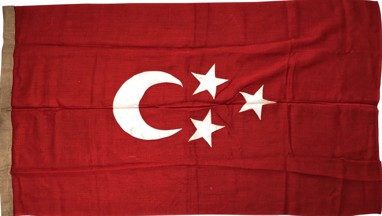 Image from William Garrison, 5 March 2018
Image from William Garrison, 5 March 2018
Do you think is a variation of the Egyptian 1940s or 1890s flag? or maybe Turkey? (image source).
William Garrison, 5 March 2018
This is not a flag I recognise, although there are similar flags from Egypt and Turkey. None with the three stars, though.
Rob Raeside, 5 March 2018
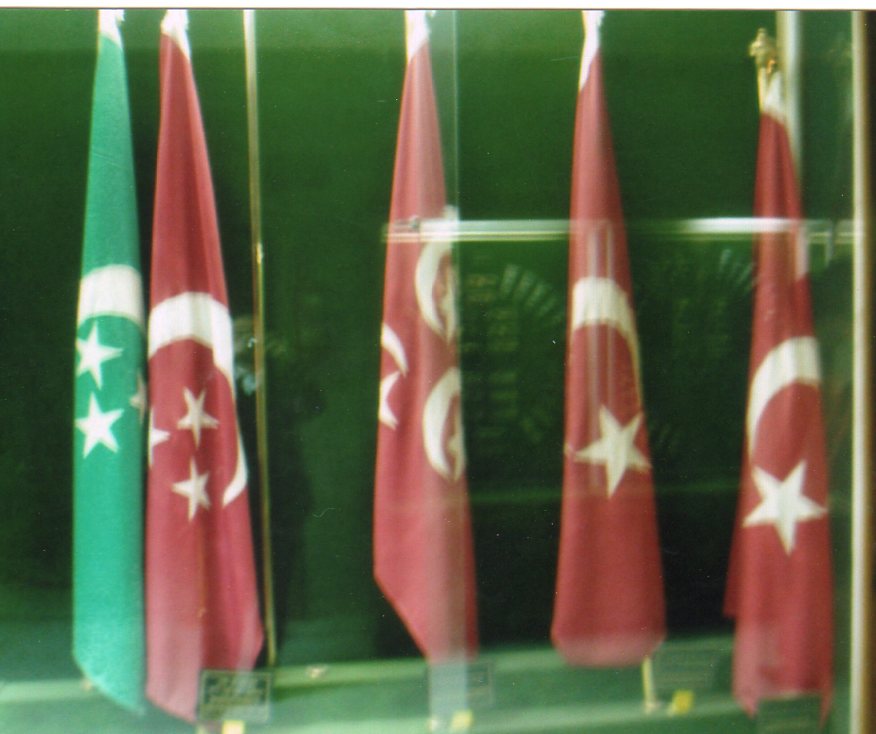

Images from Nozomi Kariyasu, 5 March 2018
FOTW shows something extremely similar as 19th century (presumably latter half) Egyptian full Admiral (2 stars = vice admiral; 1 star = rear admiral.)
The difference (between the images, but not necessarily Ottoman vs. Egyptian) is the points on the star (5 vs. 6) and the overall proportions.
The FOTW presentation (and possibly its original 1975 Dutch source) might be a bit misleading as it mixes Ottoman Turkish and Egyptian flags - Egypt being in the 19th century independent of Turkey.
T.F. Mills, 5 March 2018
I've found some sources for this and similar flags:
1. "Muhammad Ali" flag of Egypt c. 1870s (source)
2. Flag used in Egypt during the rules of Isma'il Pasha and Tewfik Pasha (1867–1881) (source)
3. Full name of Muhammad[a] Ali Pasha al-Mas'ud ibn Agha (source)
But, I don't see any link to any site showing any historical picture/image of this purported "Muhammad Ali" flag.
William Garrison, 6 March 2018
I found the following: the Khedive flag was used during
the Sultanate of Egypt. Khedive (خدیو Hıdiv) is a title largely equivalent to the English word Viceroy. It was first used, without official recognition, by Muhammad Ali Pasha (Kavalali Mehmet Ali Pasa, General Muhammad Ali of Kavala), the governor of Egypt and Sudan, and vassal of the Ottoman Empire. The initially self-declared title was officially recognized by the Ottoman government in 1867, and used subsequently by Ismail Pasha, and his dynastic successors until 1914. (source) This period is also known as Khedivate of Egypt (source), as well as relating the flag directly to Sudan and this one: "The Muhammad Ali dynasty was the ruling dynasty of Egypt and Sudan from the 19th to the mid-20th century. It is named after its progenitor, Muhammad Ali Pasha, regarded as the founder of modern Egypt. It was also more formally known as the Alawiyya dynasty (الأسرة العلوية al-Usra al-'Alawiyya). Because a majority of the rulers from this dynasty bore the title Khedive, it was often referred to by contemporaries as the 'Khedival dynasty'." (source)
Since Bill said he did not remember having seen any historical images of such flag, here are a few:
- Silk souvenir scarf with flags and emblems of Egypt (obverse) (reverse) (source). This item shows the flag in question, on the left, in an artifact dated 1900 according to source. It has been officially labeled as "Original souvenir [Souvenir of Egypt]. From the collection of Paula Sanders, Rice University." located at the Travelers in the Middle East Archive (TIMEA) (official website), supported by the Institute of Museum and Library Services (official website), Rice|Ken Kennedy (official website) and (Rice University). Also, the same website states that the flag is that of Mehmet Ali. The adjoined paragraph explains: "The Ottoman flag in the nineteenth century normally bore a white star and crescent on its red field, although both Turkish and Egyptian ships very frequently displayed the old, plain red ensign. Muhammad Ali did introduce one distinctive new flag which eventually became the first real Egyptian national flag. Perhaps to symbolize the victory of his armies in three continents (Europe, Asia, and Africa) or his own sovereignty over Egypt, Nubia, and the Sudan, Ali set three white crescents and three stars on a red field. Technically only the personal standard of Muhammad Ali--and of those who followed him as hereditary rules of Egypt under the title of khedive--the flag was at least a mark of distinction between Egypt and Turkey". This other source shows (image) (source) mentions the following: "SMALL vintage tobacco premium flag silk - brightly colored Egyptian flag - distributed between 1911 and 1916 with Sovereign Cigarettes, as part of its popular Flags of the World series. Egyptienne Cigarettes, made in New York, was one of several brands sold by the American Tobacco Company. This flag is identified "Egypt" next to the image. "Egyptienne STRAIGHTS Cigarettes" is printed along the lower edge, and the factory number and location are printed along the top. SMALL flag silks measure 3" x 1". This distinctive personal standard introduced by the Khedive Muhammad Ali - a set three white crescents and three stars on a red field - became the first real Egyptian national flag in the mid 19th century. When Egyptian nationalists in 1882 sought to depose the khedive, Great Britain - occupying Egypt to maintain the Khedivial authority - flew this flag in conjunction with the Union Jack as a symbol of the Egyptian protectorate.
During the early 20th Century, American Tobacco Company was one of a number of cigarette companies that gave free silks, flannels or leather to customers who purchased their tobacco products. These textile items were distributed either as an "insert" (sometimes in an envelope, into the tobacco packaging, and sometimes attached to the outside) or as a "premium" (given away in exchange for coupons inserted in the packaging). The small 3" x 1" silks were usually distributed as inserts with the product. The larger silks were usually premiums given in exchange for coupons." Also, this catalog chart, shows similar flags (image) (source) of the same period, which determines that such flag were used in the period of 1914-1923.
In this historical catalog (attributed to Dr. Whitney Smith in other sources) states that "Underlining his military independence within the Ottoman Empire, Muhammad Ali created a system of distinguishing flags for the navy that was different from the Ottoman system. Probably it dates back to the naval campaigns in the twenties of the 19th century. The flags were the flags for the Rear Admiral, the Vice-Admiral and the Admiral, showing on a red field a crescent with one, two and three six-pointed stars respectively. A personal flag for Mohammed Ali himself showed three crescents-and-stars on a red field and this corresponds with the rank of Grand Admiral or the Admiral of the (Egyptian) Fleet." The image describes a set of 12 flags, as follows:
Distinguishing Flags of the Egyptian and Ottoman Navy, 1841 ca" (from left to right):
First row:
1. Flag of the Government
2. Flag of the Imperial Family
3. Muhammad Ali
Second row:
4. Admiral of Egypt
5. Vice-admiral of Egypt
6. Rear-admiral of Egypt
Third row:
7. Rear-admiral of the Porte
8. Vice-admiral of the Porte
9. Admiral of the Porte
Fourth row:
10. Merchant flag
11. Grand-Admiral of the Porte
12. Merchant flag
Notice that the flag of Muhammad Ali corresponds with the flag of the Grand-admiral of the Porte.
It is possible that these flags were also the distinguishing flags of the corresponding ranks of the army but nothing is known about such flags.
The flag of Muhammad Ali himself, the six-pointed stars replaced by five-pointed ones was also flown as the personal flags of later rulers of Egypt, bearing the title of khedive and sultan. We may assume that in fact not these titles were symbolized, but the rank of grand-admiral or admiral of the (Egyptian) fleet. It was only abandoned in 1922 with the establishment of the kingdom when it was replaced by a blue flag with the royal arms between four royal crowns in the corners.
The coat of arms of the ruler of Egypt showed a crescent and three stars from about the second half of the reign of Muhammad Ali until 1952. The only exception of this rule are the arms of Abbas Hilmi II (1879-1914) who introduced a coat of arms with three crescents and stars in about 1907 and the arms of his successors, sultans of Egypt until 1922."
Now, there are four related flags:
The Ruler's Flag
- Muhammad Ali's Flag until 1848
- Admiral and Vali of Egypt's Flag at sea 1848-1867 ("flag according to Gritzner, Maximilian: Flaggen und Banner Landesfarben aller Zivilisierten Staaten der Erde. Nürnberg, 1876 Taf. 64. The stars are seven-pointed").
- Khedive's and Sultan's Flag 1867-1922: ("flag according to Admiralty's Flags of the World, 1915 but documented at least from the time of Muhammad Ali").
- Egyptian Royal Flag at sea 1923-1952: ("flag according to many contemporary sources").
The Flag
The national flag of Egypt was, in the time of Ottoman rule, the flag of the Government of the Ottoman Empire consisting of a white decrescent-and-star on a red cloth. This was the official flag until 1914/1923.
It was replaced in 1914 by the flag of the Commander of the Fleet of Egypt, consisting of three white decrescents-and-stars on a red cloth. In 1923 this flag was replaced by a white decrescent-and-three stars on a green field.
Usually the Muslim flags were flowing to the left (like Arab and Hebrew script is written from the right to the left) and, as the crescents turn their horns to the left also, they have to be called crescents increscents. In most European sources however, the flags are usually drawn flowing from left to right (the mast end at the left) and so, in that case, the crescents have to be called decrescents! (Source)
Esteban Rivera, 6 March 2017

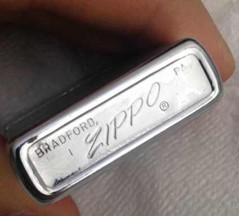
Images from Greyson Miller, 19 March 2018
A friend of mine recently discovered this Zippo lighter from 1973 at an antique store in Ohio, which had a French-looking flag that neither of us could identify. The flag has blue, white, and red vertical bars, with the white bar taking up the middle half of the flag. There is also a white star on the flag, with a printed capital "H" inside the star.
Greyson Miller, 19 March 2018
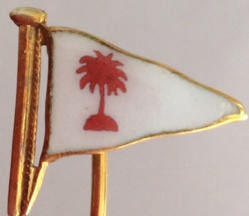 #32a
#32a
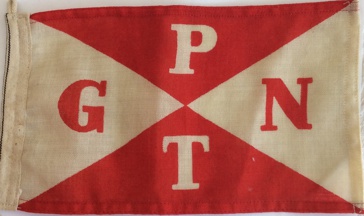 #32b
#32b
Images from Luke Jones, 26 March 2018
I've got these two flags, but I just can't find out which club or line they belong to. Any information would be greatly appreciated
Luke Jones, 26 March 2018
The PGNT flag marked as a shipping line is in fact a boating club. It is the Paddelclub "Gut-Nass" Tegel (Der Paddelclub "Gut-Nass" Tegel) located in Tegel, Berlin, Germany. It is roughly translates as "Canoe Club 'Good and Wet' Tegel". The history of the club indicates it was formed after three acquaintances had to paddle home together in a big storm.
Roger Moyer, 28 April 2018
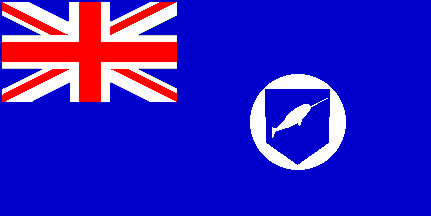 Image from Peter Hans van den Muijzenberg, 31 March 2018
Image from Peter Hans van den Muijzenberg, 31 March 2018
I'm trying to clean stuff up. This one looks like I copied something very precisely. I couldn't say what source I copied it from, just that it looks like it's from the time when I copied images as they were. This image could be over twenty years old, migrated from one computer to the next. I can see several mistakes, like I copied a sketch, or something like that. Or indeed a proposal, because the filename of the image was "proposal_a.gif". Other than that, the drawing is exactly how it survived all that time on my computers. Except, I made sure the GIF has a grey background colour and colour 0 set.
Does anyone know what we see here?
Peter Hans van den Muijzenberg, 31 March 2018
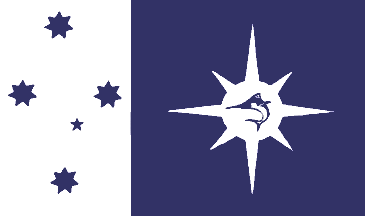 Image from Ralph Kelly, 31 March 2018
Image from Ralph Kelly, 31 March 2018
The design reminds me of the flag of proposed state of North Queensland. (North Queensland Party proposal)
The North Queensland flag includes a marlin. Could the fish on your UFE be a poorly drawn marlin? If so, then your UFE might have been an early proposal for a state flag for North Queensland, in the style of the Australian state flags, rather than the style of Australian territories that was actually adopted by the new state proponents.
Ralph Kelly, 31 March 2018
Looks like a narwhal to me. Given today's date, could it be something to do with the British Arctic Territories? ![]()
James Dignan, 1 April 2018
Yes, it definitely could. ![]()
Peter Hans van den Muijzenberg, 2 April 2018
I seem to have adopted a rather classical style of house cleaning, but I'm not really good at it. I was busy getting rid of stuff a year ago as well, and my house is still far from empty. And I noticed my mail program is slowing my computer down, caused by the more then 22000 messages in the FotW folder. I'm not all that good in cleaning that up either (though they were more than 23000 earlier): While I throw away messages I also create new ones by replying to old treads. Like this one...
OK, but if it were: What part did something like a sketch or proposal called "a", depicting "an" apparently not very recognisable, narwal on a shield on a blue ensign play in British Arctic Territories' history?
Peter Hans van den Muijzenberg, 31 March 2019.
According to the BAT Governor General's archives, in the late 19th Century, there was an idea in London of creating a British Arctic territory of sorts well before the modern BAT was established. There was talk of most of upper Canada being a territory that would have been called simply the "British Arctic". Basically, every island in the modern Northwest Territories, and Nunavut, would have made up the territory. Nunavut's islands in Hudson Bay would have been a part of Ontario or Quebec.
Someone, lost to us now in history, submitted what would have possibly been the British Arctic's blue ensign with a simple outline of a narwhal on a blue shield. Because the blue shield would've been the same color as the ensign, it would've naturally been put on a white disk, as was the practice for many British ensign badges in those days.
As Mrs. A. F. Day was creating her badge for the modern BAT ensign set, her first daughter, April, who was 10 years old at the time, suggested that mother use a polar bear instead of a narwhal, arctic aardvark, or any other indigenous animal, as the polar bear was easily the most familiar arctic animal in the world, and represented strength and nobility. Additionally, most of April's friends thought that a narwhal was only an imaginary unicorn fish.
Speaking of April, she grew up to be a very beautiful young woman and represented the BAT in the Miss Universe pageant from 2005 to 2008. April is now married, with a family of her own. She has four daughters with a fifth on the way. She eventually married a French surfer dude from Tahiti, and they divide their time between Tahiti, and the BAT. Can you imagine that contrast!!
Clay Moss, 7 April 2019
It is highly recommended you do further research on the British Arctic Territory before responding to these messages. Enjoy ![]()
These 13 Unknown Flags were sent in for identification by Fred Drews on 13 April 2018 without any text to help identify them except brief comments/titles.
Pete Loeser, 14 April 2018
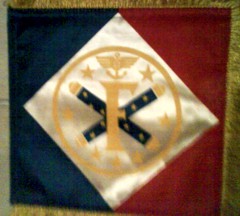 #34a (obverse side?)
#34a (obverse side?)
 #34b (reverse side?)
#34b (reverse side?)
Images from Fred Drews, 13 April 2018
Perhaps a two-sided French Air Force ensign?
Fred Drews, 13 April 2018
Once again, larger detail might help. The obverse appears to be French crossed marshal's batons. The planes on the reverse appear to be the silhouette of the SEPCAT Jaguar, used by the French Air Force 1973-2005. (Second opinion needed as I am not expert in planes.)
Could this be the personal flag of a certain Maréchal de France who had formerly been an air force officer? Again, I have no expertise in such matters, but this is nothing like rank flags located on our (Marshal of France ) or (France: Flag officers) pages.
T.F. Mills, 14 April 2018
One minor detail: the company's name is SEPECAT or the European Company of Aircraft Production School of Combat and Tactical Support Corporation(Société Européenne de Production de l'avion Ecole de Combat et d'Appui Tactique), a joint venture between Breguet and the British Aircraft. (source)
Esteban Rivera, 14 April 2017
You are close, but this is a tricky one! The unidentified flag is the unit pennant of the legendary aircraft carrier Foch (R99). The marshal's batons refer to the vessel's namesake, Ferdinand Foch (1851-1929), elevated to Marshal of France in 1918. The Foch served from 1963 to 2000, when it was decommissioned and sold to the Brazilian Navy. Renamed to São Paulo (A12), the vessel was decommissioned in February 2017.
See source#1 for a slightly different design of the pennant. See our
Ivan Sache, 15 April 2018
Planes on a narrow stripe in the blue, and the possible reverse an anchor with wings. The obvious association is a flight deck and a flight deck carrier. The batons would seem a bit high rank for a single ship, though. Who fills in the blanks?
Peter Hans van den Muijzenberg, 15 April 2018
The blanks are filled, this is a single flag, and the batons are related to the ship's namesake.
Ivan Sache, 15 April 2018
 Pennant's obverse
Pennant's obverse
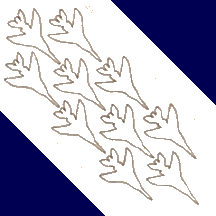 Pennant's reverse
Pennant's reverse
Images by Ivan Sache, 29 October 2018
The building of the Foch started in Saint-Nazaire in 1957.
Once completed, the hull was tugged to Brest in 1959; the Foch was inaugurated on 23 July 1960 in the presence of the Marshal's family.
Commissioned on 15 July 1963, the Foch was first stationed in Brest, before being transferred in 1976 to Toulon.
The Foch returned in April 2000 from her last operational mission, (Myrrhe), after having sailed more than one million nautical miles, representing 3,000 days at sea and 20,000 hours in service.
Sources: Dedicated section on the Net-Marine website and here for a slightly different design of the pennant.
Ivan Sache, 29 October 2018
 #34c
Image from Fred Drews, 13 April 2018
#34c
Image from Fred Drews, 13 April 2018
A UFE from Madeira?
Fred Drews, 13 April 2018
The city of Madeira, according to the silver crown of five visible towers and the gyronny of eight background. Pre-autonomy flag?
Peter Hans van den Muijzenberg, 15 April 2018
They did claim it was from Madeira, but I got it in Lisbon. (Size 5" x 7½")
Fred Drews, 27 April 2018
 Image by Sérgio Horta, 21 April 2016
Image by Sérgio Horta, 21 April 2016
I would like to point out the striking similarity between this unidentified flag and the flag of Funchal, the capital of Portugal's Autonomous Region of Madeira. The coat-of-arms is a crude version with different lettering, and the flag's colours are different, too. Hence, I cannot solve the riddle, but I hope this is able to help a bit.
Nahne Bienk, 12 October 2018
 Speculative image by Peter Hans van den Muijzenberg, 8 March 2019
Speculative image by Peter Hans van den Muijzenberg, 8 March 2019
Indeed, its symbols would appear to represent the same entity, except that different colours were used. However, according to the scroll the city is called "Madeira", rather than Funchal. Of course, it's not unheard of that an island is as its capital or vice versa. The latter is the capital of the autonomous region, but the whole construct would contain several more entities, and being non-Portuguese I won't hazard to guess which entities are called "Madeira" and which ""Funchal". So far my only guess is that before the region became autonomous, it might have been a district, which could have been called "Madeira" and might have had such a flag. Hence, my guess that it might be a "Pre-autonomy flag". I've drawn a best guess regarding what it would look like with enough light. Artists should feel free to improve; Sérgio Horta is the artist attributed for the Funchal flag drawing, that I borrowed most parts of.
Peter Hans van den Muijzenberg, 8 March 2019
The background colours in my opinion should be red and green, look at the dark gyron in lower hoist, it has the same colour as the shield background. Otherwise I agree in most points with you. The only thing really disturbing is the scroll's inscription. In the 1930s the municipal symbols project was enforced by the CHAAP, and normally the flag colours shouldn't be those of the Portuguese national flag. Some municipalities had however ignored this. As Funchal had no good reputation (see António's report) within the Portuguese government, in this case the colours might have been rejected by the CHAAP, which was no problem in at least one other city: Fiães. Maybe, the people there were less obedient. On the other hand it might be the reverse of an older Portuguese flag, it it wouldn't be gyronny. It is not more than an educated guess, but it might be more likely a rejected proposal, made between 1910 (after the monarchy had been abolished) and the early 1930s, when the municipal symbols project had been started.
Klaus-Michael Schneider, 9 March 2019
 Speculative image by Peter Hans van den Muijzenberg, 16 November 2023
Speculative image by Peter Hans van den Muijzenberg, 16 November 2023
Reading the above, I see: " However, according to the scroll the city is called "Madeira", rather than Funchal. Of course, it's not unheard of that an island is as its capital or vice versa. The latter is the capital of the autonomous region, but the whole construct would contain several more entities, and being non-Portuguese I won't hazard to guess which entities are called "Madeira" and which ""Funchal". So far my only guess is that before the region became autonomous, it might have been a district, which could have been called "Madeira" and might have had such a flag. "
If I'm not mistaken, the Madeira islands before autonomy were grouped into the Funchal district, with exceptions in the 1930-40 decades where the district was called Madeira. Maybe Antonio knows more.
Jean-Marc Merklin, 16 November 2023
"Maybe Antonio knows more." He might know more about the style. Also, I get the impression the
wedges can go either way. He might know if that's significant.
Peter Hans van den Muijzenberg, 17 November 2023
At least after 1936 and before 1959. The arms dates from 1936 but it is unclear whether the district name remained Funchal from 1901 to 1976 or whether it changed when the Estado Novo established the Portuguese provinces between 1936 and 1959. If not then the flag would be an island variant.
Jean-Marc Merklin, 17 November 2023
Specifically, it includes the speculation that the speculative image ought to have green, rather than back wedges.
I agree that the background gyronny pattern of red and green, not black,
is the correct reconstruction for this flag design.
Judging from the photo, showing a kind of trim at the right edge,
matching the top and bottom, but not at the left, it would seem that the
hoist is at the viewer’s left hand and therefore Peter Han’s
reconstruction is correct on that regard too: green over red.
maybe the scrollwork could be improved to be less in line with current standard. (What does that scrollwork say about its age?
More than the coronet and scroll styles (which could be from anywhere in
the 20th century), the contents of the shield are the arms of Funchal
already with the additional escutcheons but lacking the grape bunches,
so this would be a late 1930's design. But of course this flag itself
could be from a later time.
Fred Drews reports its size at 5?x7½? (~13×19 cm²) so it’s a handwaver,
or maybe a flag meant to be hoisted on a small watercarft. This matches
Madeira’s status as a popular tourist sailing destination.
We can be sure it is *not* any form of official flag in any capacity: it
might be a one-off souvenir flag of Madeira assembled from disparate
elements, but a design that we know never caught on. The background in
the national colors and the misuse of the capital city’s CoA to
represent the region is the kind of naive symbolism seen in memorabilia
crafted to sell to tourists.
Of course there’s no city named "Madeira", and that’s not what this flag
implies. This is just using familiar symbols (a gyronny flag with a coat
of arms on it) for a novel, unofficial use as a regional flag, created
maybe to be paired up other such subnational flags afloat on tourist
sailships. (The current Madeira CoA was created in the 1980s.)
Its true that Funchal District existed as such until 1983 and that its
territory was exactly the same as the region and province of Madeira,
but I cannot say I agree with what you say about 1930-1940. The current
18 districts of the Portuguese mainland [pt(.html], as well as the 4
island districts prior to 1983 (3 in Azores, one in Madeira) are all
named after their capitals. Two of them correspond exactly to a
historical province [pt(p.html] each: Madeira to Funchal, as said, and
Algarve to Faro.
Otherwise, the relationship between provinces and districts is
complicated and mostly not flag related, as neither had flags of their
own (the few known district flgas are all post-1974).
it is unclear whether the district name remained Funchal from 1901
to 1976 or whether it changed when the Estado Novo established the Portuguese provinces between 1936 and 1959.
The establishing of the provinces and its later gradual abandonment has
little to do with the continued existence of the districts. For a time
they officially coexisted and nothing was done to phase the districts
out in favour of the provinces. Again, not simple, and not flag-related.
tl;dr: This is an one-off souvenir flag, meant to unofficially symbolize
the island(s), was never adopted in any way and never caught on even
unofficially. It’s very interesting, nonetheless, but it’s all that it is.
António Martins-Tuválkin, 17 November 2023
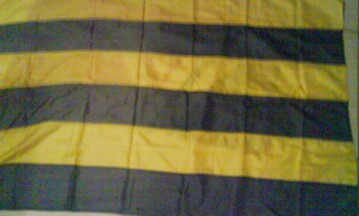 #34d
Image from Fred Drews, 13 April 2018
#34d
Image from Fred Drews, 13 April 2018
A UFE with 3 blue and 3 yellow stripes.
Fred Drews, 13 April 2018
A friend brought it in Boston. (Size 2' x 3').
Fred Drews, 27 April 2018
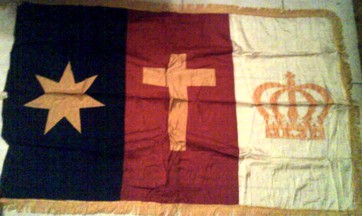 #34e
Image from Fred Drews, 13 April 2018
#34e
Image from Fred Drews, 13 April 2018
Perhaps an Australia religious flag?
Fred Drews, 13 April 2018
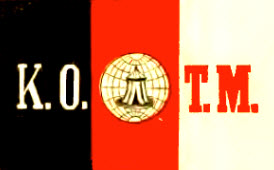 #34e
Image from Dave Martucci, 15 April 2018
#34e
Image from Dave Martucci, 15 April 2018
The three vertical stripes N-R-W suggest the flag of the Knights of the Macabees fraternal organization, although I have only seen it sometimes with the initials "K.O.." on the black and "T.M." on the white but always with a circular emblem in the center of the red bearing a tent on a globe (US Patent #D0021975, 11/8/1892 to N.S. Boynton of Port Huron, Michigan), so maybe not.
Dave Martucci, 15 April 2018
The stripes are blue with yellow star, then red with yellow cross, then white with a yellow crown with fringe. A friend brought it in Sydney, and was told it was an old Christian flag. (Size 4' x 6').
Fred Drews, 27 April 2018
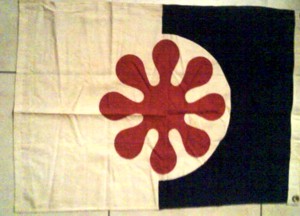
![]() #34f
Image from Fred Drews, 13 April 2018
#34f
Image from Fred Drews, 13 April 2018
A friend got it with a set of flags in Norway. ![]()
Fred Drews, 13 April 2018
I remembered Fred first reported UFE18-34f on 13 September 2010 as UFE10-44 (although with a more blue rather than black hoist color) receiving some speculation at the time, but no identification.
Pete Loeser, 13 April 2018
This is a different photograph from the one from the first time he asked. If you then have reopened communications, could he answer the questions asked so far, and maybe give us a close-up of the details?
Peter Hans van den Muijzenberg, 15 April 2018
The friend who bought it in Norway was told it was a proposal for some congress or meeting. (Size 2' x 3')
Fred Drews, 27 April 2018
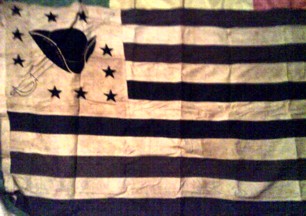 #34g
Image from Fred Drews, 13 April 2018
#34g
Image from Fred Drews, 13 April 2018
Looks a bit like a revolutionary period flag.
Fred Drews, 13 April 2018
More likely a 20th century US flag evoking the Revolution in some way (something "patriotic"?). The iconography of the sword and tricorne is definitely not 18th century. Note that there are 11 stripes, not 13. The image is shrunk too much to make out the "sword" very well. You might want to post an enlarged clos-up of the canton. The style of sword could be a major clue.
T.F. Mills, 14 April 2018
Eleven stripes blue over white. Looks unfinished with the charge of the canton looking incomplete.
Peter Hans van den Muijzenberg, 15 April 2018
 #34e
Image from Dave Martucci, 15 April 2018
#34e
Image from Dave Martucci, 15 April 2018
I can identify this flag with certainty as the Yankee Homecoming Flag of Newburyport, Massachusetts. See Flag has become festival's symbol by Victor Tine in the Newburyport News (July 30, 2010).
Dave Martucci, 15 April 2018
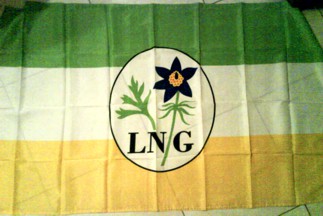 #34h
Image from Fred Drews, 13 April 2018
#34h
Image from Fred Drews, 13 April 2018
Perhaps a German city? Purchased in Germany by a friend.
Fred Drews, 13 April 2018
This is the flag of the Landesverband Niedersächsischer Gartenfreunde e.V. in Germany.
Matthew Lewis, 19 April 2018
 #34i
Image from Fred Drews, 13 April 2018
#34i
Image from Fred Drews, 13 April 2018
A West New Britain province in the canton, maybe a city in that province?
Fred Drews, 13 April 2018
Styled as an ensign including the Papua New Guinea flag and a shell, included on a flag showing an outrigger canoe. Don't know whether the details of the canoe tell us more. However, that's not really the PNG ensign, and the whole thing has an impression of a naive artwork over it. Is this actually a flag?
Peter Hans van den Muijzenberg, 15 April 2018
It has the flag of the province of West New Britain, Island of New Britain, in Papua, New Guinea, in the canton. A friend bought it in Sydney, and was told it was from a city on that island, but he forgot the name. (Size 3' x 6')
Fred Drews, 27 April 2018
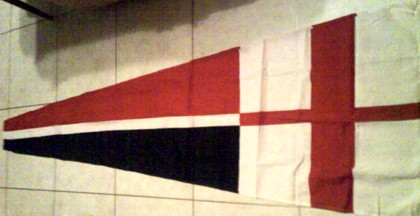 #34j
Image from Fred Drews, 13 April 2018
#34j
Image from Fred Drews, 13 April 2018
Might be an English Pennant?
Fred Drews, 13 April 2018
Blunt tip. Somewhat similar to the church pennants, but the narrow middle stripe suggests a more modern origin. A photograph that includes the hoist may tell us what the intended way of hoisting is.
Peter Hans van den Muijzenberg, 15 April 2018
I got this one at a street market in London. (Size 2' x 7')
Fred Drews, 27 April 2018
 #34k
Image from Fred Drews, 13 April 2018
#34k
Image from Fred Drews, 13 April 2018
Looks like a religious flag, says made in the US.
Fred Drews, 13 April 2018
The canton is yellow, with black emblem. The stripes are red, blue, red. It was bought at a shop in Putnam, Conn. They thought it could be a religious or an organization flag. (Size 4' x 6')
Fred Drews, 27 April 2018
 #34l
Image from Fred Drews, 13 April 2018
#34l
Image from Fred Drews, 13 April 2018
Could be a German flag? Black, red, white stripes.
Fred Drews, 13 April 2018
Has a bird on it in a style close to one we looked at earlier.
Peter Hans van den Muijzenberg, 15 April 2018
The colors are black, red, white for the stripes with golden eagle. A friend bought it in Hamburg. (Size 3' x 5')
Fred Drews, 27 April 2018